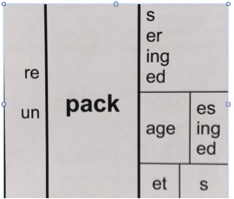English has the most words of any language and estimates range from 600,000 to more than one million words. English is derived from many languages, including Old Norse (the root of German, Dutch, Nordic languages, and English), French, Latin, and Greek, and other borrowed words from many other languages. All of this “borrowing” makes learning how to speak, read and write English quite challenging.
Parents, teachers, and reading specialists have long understood the power of phonics for young readers—in more technical terms: ‘phonemic’ and ‘phonological’ awareness builds on children’s understanding of the individual sounds in words and the ability to manipulate them and larger units of sounds, including syllables. Morphological awareness is also a key part of student development. A ‘morpheme,’ is the smallest meaningful unit of language that cannot be further subdivided.
Most educators are aware of the concept of morphology but do not receive adequate training to help their students recognize base words and patterns early on in literacy acquisition. Morphology teaches students how to unlock other related words <see example below> and broaden their overall vocabulary. It is also a bridge to other Latin-based languages. Students understand and use basic morphological knowledge as early as kindergarten and first grade.
In 2017, research by J. Kirby and P. Bowers, on Morphological Instruction and Literacy made the case for morphology being the one linguistic feature that links directly to orthographic patterns, pronunciation, and meanings of words. According to this view, better morphological knowledge gained through explicit instruction can be expected to increase not only morphological knowledge but also grapheme-phoneme and semantic (vocabulary) knowledge. This theory provides a way of understanding the literacy gains observed from early morphological instruction.
P. Bowers and J. Kirby identify nine key features of morphological instruction:
- Integrate morphology with other aspects of literacy instruction.
- Extend morphological instruction to include etymology.
- Integrate morphological instruction with subject area learning.
- Employ an inquiry-based problem-solving approach.
- Target free and bound bases as well as affixes.
- Teach morphological families using a matrix, rather than isolated morphemes.
- Target instruction to reduce the effect that phonological and spelling shifts (suffixing changes) across morphologically related words have on reading and spelling.
While most states publish academic standards that require students to analyze the morphemes to determine word meaning, there is inconsistency between academic standards and teacher training. Morphology should be taught within the context of vocabulary instruction as a strategy for understanding the relationships among words based on their shared meaningful units – i.e., their bases, prefixes, and suffixes. For example, root and base words are two different concepts. A root refers to the original word such as the Latin root word ‘placere’. Bases (either bound or free) are the morphemes derived from the original root. ‘Please’ is the base that derived from the Latin root ‘placere’.
Seeking root relationships in words helps develop curious learners. Over time, students begin to understand that most words are structured according to logical patterns of meaning and spelling. Consider that the 20 most common prefixes make up 97% of all prefixed words and the 14 most frequently used word roots provide clues to the meaning of over 100,000 words. The correlations between morphological awareness and success in reading, writing, and spelling are strong.
Whether a student is taking a science, math, or history class, morphology helps all learners, including English language learners, make important connections among vocabulary words within the same family, and transfer those ideas across content or subject areas.
For more information on Morphology training, please visit https://imse.com/training-descriptions/
Please connect with us on Facebook, LinkedIn, Twitter, and Pinterest to get tips and tricks from your peers and IMSE. Read the IMSE Journal to hear success stories from other schools and districts, and be sure to read the OG Weekly email series for refreshers and tips.

